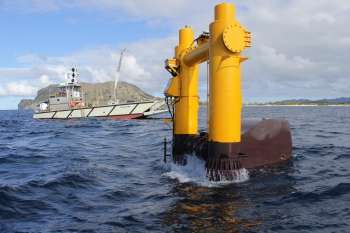July 9, 2015 weblog
Wave energy device is watched for clean power in Hawaii

The U.S. government continues its interest in wave energy, saying it is "committed to supporting the growth of this emerging technology." Supporters of wave energy hope that it will one day be an important source of clean energy, providing low-carbon electricity to places.
Marine and hydrokinetic (MHK) technologies, which generate power from waves, tides, or currents, said the Department of Energy, are at an early but promising stage of development.
Why is wave energy still at an early stage? A key factor, among any other challenge, is cost. Wind and solar have grabbed most of the renewable energy headlines in recent years as they got cheaper but, said Matt Dozier, Office of Public Affairs, that didn't happen overnight.
"Decades of research, testing and investment—much of it supported by Energy Department initiatives—have given us more reliable, cost-effective hardware, encouraging more installations and driving down energy prices. The same needs to happen for wave power."
The question has been how to generate electricity from the sea on a scale that makes economic sense, he wrote. And that is what makes a Hawaii-based project interesting. This is the Wave Energy Pilot Project from Oregon-based Northwest Energy Innovations (NWEI). The project is now at the stage of being grid-connected and is undergoing open-sea pilot testing.
Last month a prototype of their bright-yellow wave energy converter was deployed at a U.S. Navy testing site, on Oahu. It's in a 30-meter test berth.
The Azura device gets support from the Energy Department and the U.S. Navy. It weighs 45 tons but weight is not its outstanding feature. The interesting part is that it can harness movement in 360 degrees. This is special because it represents a shift in how such wave-energy devices operate.
"Waves have both side-to-side and up-and-down motion, but up to this point, almost all designs have been limited to one direction or the other," said Dozier.
Testing of the Azura device will continue for a year, and in 2017 there is potential for a full-scale demo. The Azura is connected to Hawaii's electric grid.
What are observers watching out for during this pilot test? They will monitor and evaluate long-term performance; this is the nation's first grid-connected wave energy converter (WEC) device to be independently tested by a third party (University of Hawaii) in the open ocean.
NWEI said on Wednesday that in addition to evaluating performance, data collected will enable the team to develop a more accurate assessment of the technology's Levelized Cost of Energy (LCOE), which accounts for capital cost, project development cost, life cycle costs and annual energy production.
What's next: NWEI, with $5 million in additional funding from the Energy Department, will apply lessons learned from this phase to modify design in to improve on efficiency and reliability. NWEI said on Wednesday that the device "will be deployed for 12 months of grid-connected testing as part of a rigorous program to commercialize the Azura technology."
With the improved design, according to the DOE report, NWEI plans on testing with a full-scale device rated between 500 kilowatts and one megawatt at WETS at deeper test berths of 60 meters to 80 meters over the next several years.
In related DOE wave-energy news, Mary Beth Griggs in Popular Science reported earlier this week that the DOE is sponsoring the Wave Energy Prize; registration is now closed and one can expect more interesting ideas to come. The contest is inviting teams to try to build the best wave energy device. The top prize is $1.5 million.
Again, this relates to the challenge of cost in advancing wave energy. "The wave energy industry is young and is experiencing many new innovations as evidenced by a sustained growth in patent activity," said the contest notes. "While the private industry is developing these early-concept WEC devices through design and benchtop prototype testing, funding is hard to secure for performance testing and evaluation of WEC devices in wave tanks at a meaningful scale. This is a problem for the industry since scaled WEC prototype tank testing, validation, and evaluation are key steps in the advancement of WEC technologies through the technical readiness levels to reach commercialization. "
It is a 20-month design-build-test competition. There are numerous milestones that teams will need to reach before finalists are identified, said the contest site.
Participants in the contest will design, build, numerically model, and test prototypes of a WEC device at the 1/50th and 1/20th scales.
The Wave Energy Prize has been designed to focus on deep-water devices; it chose wave conditions on the U.S. West Coast due to the large energy resource in this region.
© 2015 Tech Xplore
















